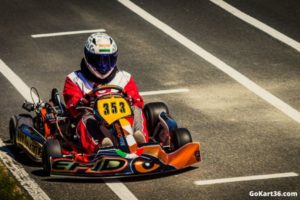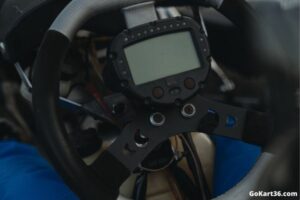
F1 Drivers that Started on Go Kart
Picture this: A Formula One racing legend takes to the track. He curves cooly around the corner, leaving all opponents far in his rearview. The

Go-karting is a matter of going fast and taking corners correctly. I learned that once you have these two skills on the track, you’ll be able to post the best times and beat the competition. I recently talked a lot about drifting a go-kart and why it isn’t the best technique to maintain your go-kart’s speed through a corner. But, if drifting isn’t good, then what should you do? Go full-throttle into a corner and hope that you don’t crash?
Well, no. Let me introduce you to go-kart braking, the best way to maintain your momentum when you’re go-karting.
But, won’t braking make you slower?
Braking doesn’t make you slower if you know when and how to brake correctly. Controlling your speed by using the brakes is super important because you’ll essentially keep your momentum when you’re turning into a corner and be able to blast off after the apex.
Go-karts grip isn’t infinite. So, when you want to take a corner, you should be at the optimal speed so that you don’t oversteer or understeer (more on that below). When you approach a corner, a general rule is to brake early if you struggle to control your kart. As you get more accustomed to the track and the go-kart, you can start braking later.
But, that’s not all. So, let’s learn how to use the brakes correctly when you’re go-karting.
Using the brakes correctly is something that I still struggle with but know is normal since it is a basic but still complicated technique to master.
When you try out new go-karts or a new track, you’ll not be able to find the perfect braking point on your first try. So, I follow this set of rules when it comes to braking.
Whether you’re on a new track or want to achieve the best time at your local one, you’ll need to keep your braking as smooth as possible. This doesn’t mean that you should start braking 100 meters before turning, but you should find the optimum braking.
The optimum braking is the most pressure you can apply on your brakes so that your kart’s wheels don’t lock up. If your wheels lock up, you’ll end up drifting across the track, and you’ll lose all your momentum. The best way to find how much pressure should be applied is to first slam on the brakes (and manage not to crash) and then slowly put less pressure on every lap.
Another beginner mistake that I used to make was braking through the corner rather than before it. For novice go-kart drivers, the optimal place on the track to brake is the straight. This way, you won’t have to manage the oversteer that comes when you brake while turning. That being said, more experienced drivers use a method called trail braking which is the opposite of what I just said.
Trail braking is essentially braking at the last second up until the apex. The driver will firstly apply a lot of pressure on the brakes, which will cause oversteer, and then they will lift their foot off the brake slowly to release that pressure.
Trail braking is a pretty dangerous braking method, especially for novice drivers. It needs a lot of practice to master it, and even when you can perform it perfectly, you might end up oversteering more than you expected.
Here’s a fantastic video from Driver61 that explains several mistakes that even professionals make when trail braking.
Another risky method of braking is power braking. Basically, power braking is braking while you still have your foot on the throttle. This will cause your kart’s engine and brakes to overheat, so if you’re not careful, you’ll end up with a broken go-kart before you know it.
The key to not destroying your go-kart is to brake slowly. Since you’ll be braking while you’re accelerating, you should find the maximum amount of pressure you’ll need to apply to the brake. Once you’ve found that, you’ll have to focus on balancing out with the throttle and, of course, following the optimal line for the corner you’re approaching.
Power braking can save you a lot of time throughout a lap, but it can also be dangerous. So, if you’re not an experienced go-kart racer, I’d highly suggest you stick to the basic braking methods I mentioned above.
That being said, both novices and professionals make mistakes. So, what mistakes should you avoid when it comes to braking?
We all make several mistakes when braking on a go-kart track. For example, I usually try to brake later than the optimal braking point, which generally ends up with me facing the opposite way. So, I’ve included some of my mistakes and mistakes that I’ve seen from other karting drivers while braking, so that you avoid them.
I know, I know, this is easier said than done. But, you mustn’t apply too much pressure on the brakes. Every corner on every go-kart track is different. So while a 90-degree corner needs little to no brakes, a hairpin needs you to be at a low speed in order to not understeer.
While you’re braking, you should focus on keeping your go-kart straight, and your foot should not press the brake pedal all the way. If you don’t do either of these, your wheels will lock up, which will waste your time and put you at risk of crashing.
Following up on what I said above, treating your brake pedal like a button is a guaranteed trip to the barriers on every turn. When you press the brake pedal all the way, you end up overheating the brakes, and you’ll also lock the wheels.
The only way to avoid this is by practicing on the track. Rent out a go-kart and accelerate slowly and when you approach a corner, apply gentle pressure on the brake pedal. Once you’ve got that in your muscle memory, start going faster and apply as much pressure as needed on the brakes.
I’ve already explained why drifting your go-kart is bad for speed. But, anyone who’s driven a kart before knows that executing a drift is inevitable since it’s usually because of accidental oversteering.
In order to not drift your go-kart through every corner, you should find the optimal braking point and the optimum braking. Once you know that, you shouldn’t face any problems with oversteering.
While this expression can be used everywhere, it has a great meaning in go-karting. You should always be looking ahead when you’re taking a corner. Once you know how much you need to brake before a specific corner, you should focus on the braking point as you’re approaching the corner, the apex as you’re turning in, and the exit of the corner once you’ve hit the apex.
So, that being said, I think it would be interesting to see some of the main differences between the front and rear brakes in go-karts.
Before I go on, let me explain the difference between front and rear brakes. For starters, front brakes are attached to the front wheels, and the rear brakes are connected to the rear wheels. Unlike F1, where the brake bias is towards the front, go-karts have a bias to the rear.
Two brake systems are not really common in the karting scene. Most of the time, front and rear brakes can be found in shifter karts since shifter karts are meant to mimic regular cars. But, most go-karts have brakes on the rear.
I recently went karting with some friends who are huge F1 fans but know nothing about karting. Their main question is why most go-karts oversteer, compared to F1 cars that understeer.
Well, this can be explained with some simple physics. In F1 cars, the bias is on the front, so the front wheels are more likely to lock up. Now, let’s use common sense. The front wheels are always closer to the corner, so if they don’t turn, the car/go-kart will end up going straight, so it will understeer.
In go-karts, the brakes are solely on the rear, most of the time. So, this means that the front wheels turn while the rear wheels remain practically stationary. As a result, the go-kart ends up oversteering or drifting.
However, there are times where you might be doing everything correctly, but your brakes just don’t work correctly.
While brakes and cars are really different, their brakes are pretty similar. So, if you know when your car’s brakes require replacement, you’ll know when to replace your go-kart’s brakes. That being said, let’s see at some clear indications that your brakes need to be replaced.
When any component of a go-kart starts sounding weird, it’s probably worn and needs to be replaced. If your go-kart’s brakes begin emitting a high-pitched sound when you put pressure on the brake pedal, then you’ll need to replace the brake pads.
If, however, there’s a grinding noise when you brake, then there’s a problem with the brake disc. This needs immediate service since it can overheat the rest of the kart and do more damage.
Brakes should have some resistance when you apply pressure to the pedal. If the pedal is soft, and you can easily press it to the floor, then there’s a problem with the master cylinder, or there’s air somewhere in the braking system.
While this might also be from the engine or the clutch, any type of burning smell needs your immediate attention. If it’s coming from the brakes, then it means that you’ve overheated them. If the smell is accompanied by smoke, then the brake caliper is in need of replacement.
This is all I had to say about braking in go-karting. In reality, if you’re a beginner, you won’t have to worry about replacing the brakes since you’re probably driving rental karts. You should focus on having fun on the track and learning how to brake appropriately. Remember that practice makes perfect!
Stay tuned for more articles just like this one!
The best place to brake on a go-kart is on a straight part of the track before the corner. Some professional drivers use different braking methods, some of which are mentioned in the article.
Yes, you can trail brake on a go-kart. While it’s not the easiest and safest method of braking, it can make you go a couple of tenths faster, as I mentioned above.
If you have any more questions that you’d like me to answer, be sure to contact me or leave a comment below.

Hi, I'm Dor and since my first lap on a go-kart in Italy, karting became my favorite hobby. I check tracks in many places around the world and am happy to share from my experience.
In my daily job, I am a programmer, and during the season, I race in my local league in the senior category.

F1 Drivers that Started on Go Kart
Picture this: A Formula One racing legend takes to the track. He curves cooly around the corner, leaving all opponents far in his rearview. The

Go Kart Racing Wheels Sizes Guide + Size Charts
Since I started to race in a local league I started to understand that there are a lot of factors that affect the lap time,

Tips for Buying a Used Go Kart!
Go-karts are incredibly expensive machines, and if you’re getting into the sport you need to make sure that you stick to your budget. The kart

Indoor Go Kart Racing: Is it the same as outdoor tracks?
If you are looking for an adrenaline rush, an indoor go-kart racing track is one of my favorite places to go. If you are following

How fast does a go kart accelerate?
Go-karts might be small and lightweight machines, but they are incredibly fast. You might be thinking about the rental karts you find at your local

Go Kart Data loggers: MyChron5 vs Alfano 6
Data loggers are almost essential in modern karting. They can help to improve your performance and they are very helpful if you have a coach

Want to get updates on new posts or events from my blog?
Join the newsletter and I will make sure you will be updated.
* Promise you will not get spam and I will never share your information with a 3rd party.